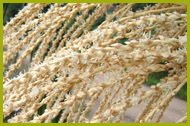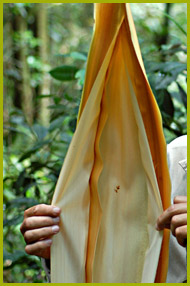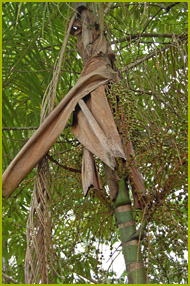|
|
The inflorescence is a 50 to 80 cm long infrafoliar spike of erect floral branches, branched on the level of first order, composed by several rachillae, covered with very short, rounded, granular hairs. The latter can be used to differentiate E. edulis from the other Euterpe species (HENDERSON 2000). The number of branches varies from 96 to 175 per inflorescence. E. edulis, as most green plants, is a monoecious plant (from the Greek oykos, which means home) in which each individual has sexual structures of both sexes. The flowers are unisexual, with both sexes in the same inflorescence, males occurring in much higher number distributed at the ramifications in triads, one female between two males. Staminate flowers 5-6 mm long, purplish; sepals deltate, 2 mm long, gibbous; petals lanceolate, 5 mm long, filaments 1.5-2.5 mm long, flattened; anthers 2.5-3 mm; pistillode almost 1 mm long, trifid at apex. Pistillate flowers 3-4.5 mm long; sepals very widely ovate, 3-4 mm long; petals very widely ovate, 5 mm long (HENDERSON 2000).
|
|
|
Each ramification has between 53 and 162 female flowers. The male flowers maturate earlier (protandry) avoiding autogamy of the individual. It opens about 7 days before the female. Both, male and female flowers, have a sweetish smell, produce nectar and open in the early morning. But while the male flowers fall to the end of the day, the female's last at least 2 days.
During the development of the inflorescence the bud is surrounded by a large woody bract (central axis 0.5 m). Each plant produces 1 to 5 inflorescences which are inserted beneath the palm heart and more or less horizontal when the flowers open. First flowering occurs around the 6th or 7th year. Depending on the location, flowering of this species is a single episode which begins at the end of the dry season (August, September) and occurs from November to February (MATTOS & MATTOS 1976, FISCH et al. 2000).
|



